
Science Education Center of California

Science Education Center
of California
231 Rochester St.
Costa Mesa, CA 92627
714-292-6845
krawitz@sprynet.com
![]()
Science Education Center of California
Antiques & Antiquities
Silver Ingots |
^ top ^ | |
 |
 |
 |
 |
 |
 |
 |
 |
 |
| Prices: All silver bars are
$9 - $10 per ounce with the exception of the three bars in
the center photo, which are priced separately. The center bar
in the center photo is from the San Francisco Mint and has
already been sold. The two bars to the left and right of the
San Francisco mint bar are priced at $300 each, and were produced
by Hallmark precious metals (10.26 troy oz) and Hoffman and
Hoffman (5.13 troy ounces).
Background: Many of the hand stamped silver bars of the old west were melted during the great price spike of the early 1980s when the Hunt brothers cornered the silver market and the price of silver went to $50 per ounce. A few survived with most ranging from a few ounces to 100 ounces in weight. Most have the weight and purity hand stamped on either the top or side of the bar and have varying degrees of surface oxidation (patina) which has built up over the years. Many of the bars have an attractive toning and were purchased for their ascetic as well as historical importance. |
||
Silver Coin Bags from the Old West |
^ top ^ | |
 |
 |
Price: All coin bags are priced at $150 each. |
| The Gila Valley Bank and Trust Company
(Globe, Arizona) A well preserved cloth coin bag for holding 100 silver dollars, and displaying the following text at the top of the bag: LAWRENCE MAKER, Saratoga, N.Y. |
The First Central National Bank (Calexico, Calif.) An extremely well preserved leather pouch from a small border town in the Imperial Valley. The drawstring at the top is fully functional and allows for the bag to be tied and sealed for secure transport. |
|
 |
 |
|
| Metals Bank and Trust Co. (Butte, Mont.) A used coin bag (some fading of text) for silver transport in and around the mining district of Butte, Montana. As in the other bags, the typical contents would be 100 silver dollars. |
Ass’t Treasurer So.Pac.Co. (San Francisco) A well used canvas coin bag (some staining on the obverse and reverse sides) from the center of the California Gold Rush. The serial number at the top of the bag reads “8-7-16-5000-S.1769”. The bag is an original artifact from the Southern Pacific Railroad and may have been used to transport coin or currency on their local and interstate runs. |
|
Blacksmith Items |
^ top ^ | |
 |
 |
 |
| Background: The Krawitz
blacksmith collection features over 30 hammers and mallets (and
related items), two anvils, as well as an assortment of tools
and survey items. The hammer collection includes pounding tools
made from copper, rawhide, wood, brass, stone, and various types
of steel.
Left Photo: A well-preserved
mallet (original handle) containing a curved portion for shaping
wagon wheel rims and other non-linear pieces of metal. With
a handle approaching 30 inches, this mallet is the longest
in the Krawitz collection. Center Photo: A well-used copper
hammer of soft composition and displaying a brassy patina
along the head of the mallet. Numerous scuffs, scratches and
dents on both sides attest to the hammer’s soft surface.
Small quantities of red paint still adhere to the curved portions
and the word “copper” is visible (but weak) along
the side of the hammer. Right Photo: A mallet with an
inwardly curved portion on one side and a well pounded flat
head on the opposite side. This type of mallet was typically
placed between a metal surface (being shaped) and a large
hammer. Repeated striking of the flat portion of the mallet
would impart sufficient kinetic energy to the curved portion
to shape a piece of softer metal. |
||
Blasting Antiques |
^ top ^ | |
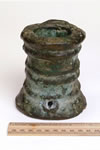 |
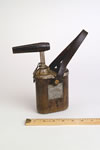 |
|
| Left Photo: Locality: South America (1690-1850’s) Uses: The device could be used
to either burn a charge for signaling a nearby ship, or to
house a metal projectile for firing on objects at close range.
The relatively short barrel (3.5 inches) would indicate the
former use as being most likely. Right Photo: Item: U.S. Army Blasting Machine (10 CAP) Comments: This antique hand operated
generator probably dates back to WWII and is designed to produce
an electric current for portable electric energy needs. This
device is similar to the plunger type of blasting machine
in principal, but is smaller and uses a rotating handle rather
than a vertically oriented plunger. |
||
Assay Office Artifacts |
^ top ^ | |
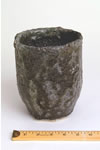 |
 |
|
| Left Photo: Locality: Assay office of Dr. Ralph E. Pray Composition: Graphite crucible coated with a glassy slag. Size: 7 inches tall and 5.5 inches wide Price: $95 Comments: A fascinating object
and part of Dr. Ralf Pray’s assay office (see background
below) during its hey day of production. Metallic particles
and ore residue (imbedded in the glassy slag) gives the specimen
a dark glazed look. Right Photo: Background: |
||
Lanterns & Torches |
^ top ^ | |
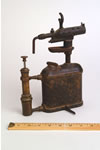 |
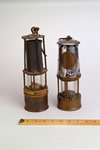 |
|
| Left Photo: Locality: This torch was purchased in Magdalena, New Mexico. Composition: All parts and fittings are composed of brass. Size: 10 inches tall and 7 inches long Comments: This hand operated torch was probably used in the highly productive lead, zinc and silver mines that flourished in the mountains to the west of Socorro, New Mexico. A pair of rotating feet extend 1.5 inches on either side of the torch and were designed to stabilize the highly elongated torch in a vertical position. Right Photo: Locality: European in origin Size: 9 to 10 inches tall with a maximum
diameter of 3.5 inches Comments: The shorter lantern was manufactured in Manchester, England by the Protector Lamp & Lighting Company. A crown emblem is engraved on the glass and the word “British” appears over the crown. The taller lantern has horizontal markings on the glass with the lowest 2 markings labeled 1% and 2%. The text BM 399/60 appears on the brass housing above the fuel tank. |
||
Mining Equipment |
^ top ^ | |
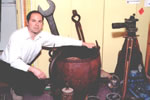 |
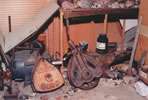 |
|
Together with the assay office specimens, the
mining collection at the Science Education Center is a well-assembled
collection of artifacts from the Western States. The collection
includes ore buckets, windlasses, mining pumps, high capacity
pulleys, survey equipment, historic books on mining and exploration,
etc. A few items are listed below:
|
||
Planning a Visit | Site Map | FAQs | Links
© Copyright 2024 Science Education Center, all rights reserved.